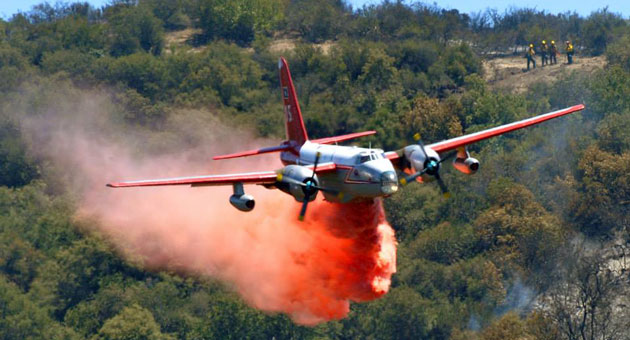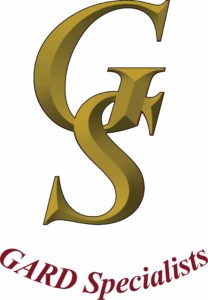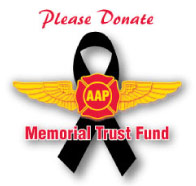Watching the news footage of the White Fire in Santa Barbara County in California today and other recent incidents in Australia, I wonder why so many fire agencies are locked into their thinking about doing the same thing the same way and make no improvements in performance. Watching air tankers trying to drop long term on ridges in high cross winds and missing targets and helitankers dropping water only and watching it drift away into the wherever seems such a waste of time and valuable taxpayers’ money. Am I just making comments like this as I develop into a grumpy old man, or are agencies so risk averse that doing something out of the ordinary may make them liable for an inappropriate or courageous decisions?

Firefighters watching a P2V drop long term retardant on the White Fire
Mike Eliason photo / Santa Barbara County Fire Department
Pilots and operators generally are limited by agency practices and procedures and willingly do anything asked of them in the name of continuing income and contracts. An organisation such as I work for, a fire suppressant company, can only hope for a break in the norm by making fire agencies, and encourage them to see methods to improve effectiveness and potential cost savings.
We see the aerial firefighting debate on VLATs and Air Tankers saying this aircraft is better than that one, that one is too old and not designed for the role, contracts awarded for machines that have not demonstrated themselves to be effective yet, and policy dictating only long term retardant can be used in large air tankers and so on. When is the debate going to start on whether the systems, policies and the drops from aircraft are meeting the community safety outcomes such as minimizing the loss of life and property from wildfires? Are the current strategies and tactics by the agencies with the money provide an equitable solution for meeting this outcome?
There is almost a propensity to idolize aircraft by the media and the aircraft followers rather than critically review whether are they being effective. Are the procedures correct, does the bombing system give the best possible outcomes for the tactic applied, and is the chemical applied being effective in the climatic conditions? These factors are often overlooked as we watch the the local TV news focus on the spectacular shot of a fire and an aircraft dropping something. Ask yourself this. When was the last time you saw a TV news cameraman focus on the drop effectiveness rather than the plane after a drop?
So what are the factors that affect delivery performance in aerial firefighting?
- Human Factors : This includes team dynamics and crew culture; skills, knowledge and abilities; leadership and its less well known partner follower-ship; decision making ability; and communication
- Equipment Factors: This takes into account ground support, mixing system and complexity of operation; aircraft type and its respective delivery system
- Environmental Factors: The weather, terrain and vegetation structural formation are all critical factors affecting how well aerial firefighting is delivered
- Suppressant/Retardant Product Characteristics: This includes extinguishing effectiveness; toxicity to the environment (residual factors); delivery characteristics; cost per gallon or litre delivered to the fire; its mixing characteristics; and the cost of support infrastructure
- Procedural Development: This is without doubt possibly the greatest influence delivery performance. Factors include procedural maturity; risk assessment process at a strategic and tactical level; what decision making models are used if any; are there relevant pilot company operational manual for aerial firefighting; and finally the clarity of the agency’s Air operations manual.
These factors as most emergency managers should know occur over a continuum from a planning to a review stage. The focus must change to a holistic view of the aerial firefighting program rather a single point debate on aircraft on type, chemical used or a fixed policy to be followed. Challenging the existing paradigm without prejudice is a noble ideal of mine, but will we have the courage to put this into practice?











David–Outstanding analysis! This kind of dialog is what AAF is aiming for.
I think you’re right that we take for granted the public’s perception of our product. I think it’s a noble cause to honestly analyze ourselves, because at the end of the day we’ll have a gauge from which to do better.
Believe me…you are not the only one thinking of this. We need to be able to quantify why fighting fire from the air is a good thing.
David,
excellent analysis and valid points!
What’s missing also, in my opinion, is R&D…
R&D to redefine tactics based on all combined factors; Fuel type, terrain, weather, aircraft available/necessary, Fire suppressant type, Dispatch/organization of operations, timing, etc..
So far the best philosophy/tactic is “rapid response. Hit hard when it’s small” : aka: Initial Attack. And this is efficient with high percentage in California.
Can we improve the system? yes!
How? well… first let’s talk about it. Appreciate what we have and learn lessons of the past. Let’s create R&D for Aerial Fire Fighting.
Question 1: Do we want to put out the fires or manage the fires? Yes, no, maybe…
Question 2: Would agengies be willing to share stats, knowledge, studies and create an R&D Group involving people from all branches; Labs, Foresters, firefighters, pilots, etc
Let’s keep searching and learning.
Cheers
Jerome
It’s nice to talk about something other than hardware. With aircraft it has what’s available and cheap, then putting a square peg in a round hole. Seems like it would be more productive to analyze the where and why we fight or manage fires before picking tools. Hopefully, we will have some good tools in the near future and the various agencies that employ them will use them with discretion and forethought. Kind of like having the appropriate software and operating system. Thanks for the conversation David.
Dean,
Don’t forget the real and only question that matters.. The Mother of all question marks.. : “Hu Khayr ?”
“Who cares?” would be the closest significant translation of this crucial interrogation.
If decision makers can answer it positively and act accordingly with good will and common sense, we may see interesting changes soon.